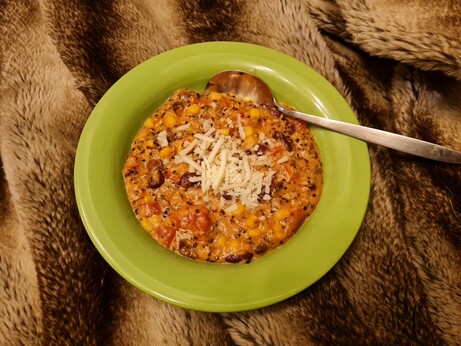MagdalenaBerlin 🌎 🏳️🌈 · @MagdalenaBerlin
225 followers · 2097 posts · Server troet.cafe@truhe
Mir ist gerade dieses Rezept in den Weg geflattert und ich habe mich daran erinnert, dass du kürzlich nach #Quinoa-Ideen gefragt hast. Es lässt sich gut veganisieren. Ich bin jedenfalls sehr gespannt darauf, es auszuprobieren.
Ich bin besonders gespannt auf die Creme mit Lavendel, da es in meiner Suche um Rezepte mit Lavendel ging... 😋
⬇️
https://www.chefkoch.de/rezepte/4242451690151486/Chili-Quinoa-Baellchen-auf-Zwiebel-Paprika-Gemuese-mit-gebratenem-Pfirsich-und-Basilikum-Lavendelcreme.html
LizzyNet · @LizzyNet
59 followers · 212 posts · Server nrw.socialFragt ihr euch auch manchmal: Was ist von #Superfood zu halten? #Avocado, #Quinoa & Co. sind sehr gefragt. Aus ökologischer und sozialer Sicht sind regionale Alternativen aber besser, rät die #VERBRAUCHERINITIATIVE #Nachhaltigkeit #Klimaschutz #Umweltschutz #Ernährung
https://www.lizzynet.de/superfood-nicht-so-super.php
#Superfood #avocado #Quinoa #verbraucherinitiative #nachhaltigkeit #klimaschutz #umweltschutz #ernahrung
Jack Conners (He/They) · @connersjackson
293 followers · 1721 posts · Server climatejustice.socialMany #superfood trends contribute to environmentally-degrading #monoculture practices to keep up with demand, particularly with #crops and places in the #GlobalSouth where monoculture hasn't traditionally been used to grow those crops. It also leaves the communities that grow them economically vulnerable when the trend inevitably fades.
#Kale may be an exception to this, since it grows well in gardens in temperate climates. But generally, trendy superfoods tend to be "exotic" crops from the tropics, or the Global South more broadly. There's often an indigenous cultural association that gets appropriated by the trend.
The one I know the most about is #quinoa. Quinoa is a grain which has been cultivated for millennia by indigenous Andeans, since it grows well in high and dry areas such as are common in the #Andes. It filled some #nutrition gaps that would have otherwise been present in a typical Andean diet: in particular, as a high-protein grain, it helped make up for the relative scarcity of meat. This is not something that most Americans who can afford to partake in superfood trends have to worry about.
Traditionally, quinoa had been grown in small crops by subsistence and small-scale farmers, alongside other crops like corn and potatoes. But when it became a superfood, it suddenly became profitable to grow large fields of only quinoa. These fields expanded rapidly onto fragile soil, depleting the scarce water and nutrients that had taken very long periods of time to incorporate into the soil.
The #ecosystem that depended on the soil collapsed. For a while, the farmers who made the transition to monoculture were making more money, but even then, most of the profits went to the corporate distributors in the US, and those farmers who couldn't or didn't make the switch were pushed out of the market. Then, when the trend faded, the money stopped coming in altogether, leaving indigenous Andean communities without money or ecological well-being, while Americans simply moved on without a second thought.
Almost all superfoods can be nutritionally replaced with more local crops, in combination. #Açaí, for instance, is considered a superfood because of its high content of antioxidants, fiber, omega-3s, and calcium. Blueberries and spinach (they don't have to be in the same meal) together have the same properties. Beans and rice are a combination that has been independently invented in a variety of different versions around the world, largely because they are two staple crops that form a complete protein together. They can replace quinoa, especially if you use brown rice.
It can be exciting to try foods from another place. It can feel adventurous and cosmopolitan. It can also help us connect with the people and cultures from which it comes, but only if we fundamentally change the way we approach it. Our current way of thinking and doing, when it comes to trying new foods, is deeply rooted in #colinialism. Superfood trends are a prime example of this fact.
Lastly, the idea that we need to eat certain foods and have a certain diet to be healthy is inherently #fatphobic. Health is systemic, and goes far beyond individual consumer choices. Nobody can sell us good health, and our belief otherwise only serves to give money to capitalists. The pressure to have the right diet, and to appear healthy under a fatphobic conception of what that means, creates immense social and psychological harm to people who can't. That harm is vastly greater than any actual harm to health from being fat itself. And there are many reasons why people can't meet the pressures of fatphobic society: poverty, disability, etc. It isn't any of our business, or our job to "fix" fat people; we need to fix society instead. We also need not fear becoming fat: that's being afraid of being like another real person, and also big business for #capitalism.
#superfood #monoculture #crops #globalsouth #kale #Quinoa #andes #nutrition #ecosystem #acai #colinialism #fatphobic #capitalism
Die mit den Katzen · @Iris_Ihmmal
4 followers · 33 posts · Server freiburg.socialIch liebe es, im Winter meinen Slowcooker anzuschmeißen 😊 da kommen meist leckere, deftige vegane Eintöpfe (neudeutsch: Onepot 😉) dabei heraus und es ist auch eine energiesparende Art zu kochen....
Heute gab es ein veganes Tex-Mex-Quinoa mit Mais, Kidnesbohnen, stückigen Tomaten, Quinoa, Oatly Frisch"käse" Natur und ein wenig Streu"käse" von Violife 😋
#SlowCooker #veganessoulfood #quinoa #eintopf #oatly #violife
#SlowCooker #veganessoulfood #Quinoa #eintopf #oatly #violife
Jennifer Vreeland · @jvreel
1 followers · 20 posts · Server mstdn.socialI hope you’ll stay for dinner, because I’ve made red beans and quinoa and there’s a lot of it! This is just like spicy red beans and rice, but with a little protein-boosting swap. #myautumnkitchen #cooking #quinoa #vegetarian #vegan
#Vegan #vegetarian #Quinoa #Cooking #myautumnkitchen
maxi #NoEdits #TootNotPublish · @maxi
124 followers · 2043 posts · Server todon.eu@bundeskater Oh, das es regionales #Quinoa gibt wusste ich noch nicht. Ansonsten vermeide ich das ja, weil ich es ziemlich unnötig finde, (Pseudo)Getreide quer durch die Welt zu schiffen



